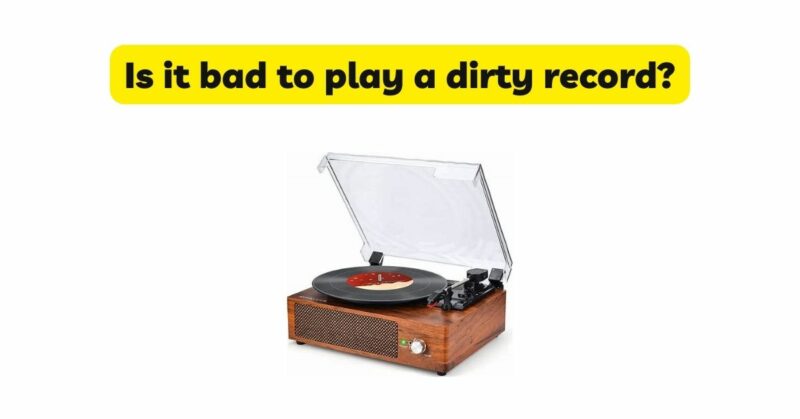Vinyl records have experienced a resurgence in popularity, captivating audiophiles and music enthusiasts worldwide with their unique warmth and analog charm. However, the question of whether it is bad to play a dirty record remains a topic of concern among collectors. In this article, we will delve into the effects of playing a dirty record on sound quality, record condition, and the overall health of your turntable system. Additionally, we will discuss the importance of clean playback and explore various cleaning methods to help you maintain your vinyl collection in optimal condition.
The Impact of Dirt on Vinyl Records:
Dirt and debris, such as dust, fingerprints, and oil from handling, can accumulate on the surface of vinyl records over time. When played without proper cleaning, these contaminants can lead to several negative effects:
a. Sound Quality Degradation: Playing a dirty record can introduce unwanted noise, pops, and crackles into the music. The presence of dirt in the record grooves interferes with the accurate tracking of the stylus, resulting in compromised sound quality and reduced enjoyment of the music.
b. Increased Stylus Wear: As the stylus moves through the dirt-laden grooves, it experiences additional friction and wear. Over time, this can lead to premature stylus deterioration, potentially requiring more frequent stylus replacements.
c. Record Groove Damage: Fine particles on the record’s surface can embed themselves into the grooves. When the stylus encounters these contaminants, it may create additional scratches or widen existing ones, leading to permanent groove damage. This not only negatively impacts sound quality but also diminishes the record’s value and collectability.
The Risks of Playing Dirty Records:
Playing a dirty record poses several risks to both the record and the turntable system:
a. Tracking Errors: Dirt on the record’s surface can cause tracking errors, causing the stylus to lose its path or skip across the grooves. This disrupts the smooth playback of the music and can lead to further groove damage.
b. Stylus Clogging: Dirt and debris can accumulate on the stylus tip during playback. A clogged stylus struggles to maintain proper contact with the grooves, resulting in distorted sound and potential damage to the stylus itself.
c. Contamination Transfer: Playing a dirty record can transfer dirt and debris from the record to the stylus, and subsequently to other records played afterward. This contamination chain can cause cumulative damage to both records and the stylus.
The Importance of Clean Playback:
Clean playback is essential for preserving the integrity of your vinyl records and ensuring optimal sound quality. Regularly cleaning your records and following clean playback practices offer the following benefits:
a. Enhanced Sound Quality: Clean records allow the stylus to track accurately and retrieve more faithful reproductions of the original recording. This results in a richer and clearer sound, enhancing your listening experience.
b. Prolonged Record Life: Proper cleaning and care extend the lifespan of your records. By removing dirt and debris, you minimize the risk of groove damage and stylus wear, preserving your records for generations to come.
c. Improved Stylus Lifespan: Clean playback reduces friction and wear on the stylus, prolonging its life and minimizing the need for frequent replacements.
d. Maintained Turntable Health: Clean records promote smooth and accurate tracking, reducing stress on the turntable’s components and ensuring its longevity and reliability.
Methods for Clean Playback:
To enjoy clean playback and maintain your vinyl collection’s health, consider implementing the following cleaning methods:
a. Dry Brushing: Use a carbon fiber brush to gently remove loose dust and debris from the record surface. This method is effective for regular maintenance between more thorough cleanings.
b. Wet Cleaning: Wet cleaning involves using a record cleaning solution and a microfiber brush or cloth to remove stubborn dirt and contaminants. Apply the solution to the record’s surface, gently scrub in a circular motion, and dry with a clean cloth.
c. Record Cleaning Machines: Record cleaning machines offer a more automated and thorough cleaning process. These machines use a combination of cleaning solutions, brushes, and vacuum suction to deep clean records, removing dirt from the grooves effectively.
d. Ultrasonic Cleaning: Ultrasonic cleaning utilizes high-frequency sound waves to agitate and remove dirt from the record’s surface. This method provides a deep clean, but it is typically more expensive and requires specialized equipment.
e. Proper Handling and Storage: Minimize the accumulation of dirt and debris by handling records with clean hands and storing them in protective inner sleeves and outer jackets. Avoid touching the playing surface as much as possible.
Conclusion:
Playing a dirty record can have detrimental effects on sound quality, stylus lifespan, and overall record condition. However, by adopting clean playback practices and incorporating regular record cleaning into your routine, you can minimize these risks and maximize the enjoyment of your vinyl collection. Clean records not only provide superior sound quality but also contribute to the preservation and longevity of your cherished records and turntable system. So, take the time to clean your records properly, handle them with care, and reap the rewards of a clean and vibrant vinyl listening experience.


